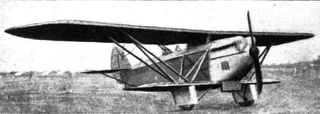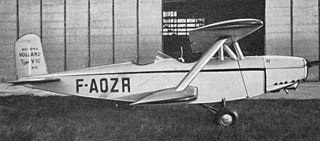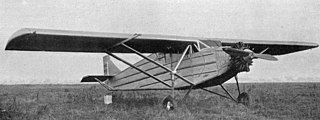Related Research Articles
The Latécoère 14 and Latécoère 16 were similar French passenger and postal aircraft of advanced design built in 1923. They differed chiefly in engine power. Only one of each was constructed. The 14's type number was reused for an unrelated parasol wing prototype that was basis of the more successful Latécoère 17.

The Caudron C.230 was a sporting, touring and trainer aircraft produced in France in 1930. It was a conventional biplane with single-bay, unstaggered wings of equal span. The pilot and a single passenger sat in tandem open cockpits. It featured a wooden fuselage with plywood skin.
The Hennion was a two seat French training and touring aircraft, completed just before World War II began. It was flown again post-war and later fitted with a new engine; it survived into the early 1960s.

The Caudron C.430 Rafale was a fast, two seat French touring monoplane. Soon after its first flight in 1933 it set an international class speed record.
The Caudron C.251 Et-2 was a French tandem seat, open cockpit biplane designed as an intermediate trainer and built in 1931. It did not go into production.

The Caudron C.140 was a French tandem cockpit sesquiplane designed in 1928 as a combination of liaison aircraft and observer and gunnery trainer.

The Caudron C.67 was a simple single seat biplane with a low powered engine. It was built and flown in France in 1922.

The Descamps 17 A.2 was a two-seat reconnaissance fighter built under a French government programme of 1923. Two versions, with different engines, were tested and six examples were built under licence by Caudron as the Caudron C.17 A.2.
The S.E.C.A.T.-VI La Mouette or S.E.C.A.T. 60T La Mouette was a French two seat tourer built shortly before the outbreak of World War II.

The SFCA Lignel 20 was a French, single engine, low wing monoplane, one of a series of this type built by SFCA in the 1930s. It was capable of aerobatics but was primarily a racing aircraft.

The Buscaylet-de Monge 7-5 was a twin engine, twin-boom aircraft without a fuselage but with pilot, passenger and fuel accommodated in a thickened wing centre-section. It was designed by Belgian pioneer Louis de Monge and built in France in the mid-1920s.
The Caudron C.580 was a French advanced trainer aircraft intended to prepare pilots for the new low wing monoplane fighters of the mid-1930s. It did not go into production and only two were built.
The Gaucher RG.40 Week-End was a high-wing, two-seat, low-power, touring aircraft built in France in 1935. Three were built and later SECAT produced several rather similar designs, all from designer Rémy Gaucher.
The Duverne-Saran 01 was a twin engine, three seat touring aircraft built in France in the mid-1930s. Only one was completed.
The Caudron C.570 was a French twin-engine aircraft designed and built by Caudron in the mid-1930s. It was designed to function in multiple roles; as a bomber, passenger transport, paratroop aircraft, cargo aircraft and air ambulance.

The Morane-Saulnier MS.350 was a French aerobatic trainer flown in 1936. Only one was built but it had a long career, flying post-war until the 1960s.

The Volland V-10 was a French two seat, low-powered biplane notable for its extreme stagger. It first flew in 1936 and appeared at the Paris Aero Salon that year.
The Bréguet Colibri was a low power, single seat French monoplane designed to compete in a 1923 newspaper-sponsored contest between such aircraft. Only one was built.

The Aviaméta 92 was a French, all-metal, five seat monoplane built in the late 1920s. Three different engines were fitted, and one example flew the first non-stop Paris-Algiers flight in preparation for an abandoned trans-Atlantic attempt.
The Caudron C.92 was a passenger transport built by Caudron in 1925, powered by a 370 hp (280 kW) Lorraine-Dietrich 12D. Only one was built, and it was discarded in July 1934.
References
- 1 2 3 4 5 6 Frachet, André (8 June 1939). "L'avion de performance Caudron "C-860"". Les Ailes (938): 9.
- ↑ Phillipe Roland (5 September 1938). "AVIATION". Le Figaro.
- ↑ Phillipe Roland (11 September 1938). "AVIATION". Le Figaro.
- ↑ "Les avions en essais". Les Ailes (902): 10. 29 September 1938.
- ↑ "Les avions en essais". Les Ailes (919): 8. 5 January 1939.
- ↑ "Les avions en essais". Les Ailes (922): 9. 6 February 1939.
- ↑ "Les avions en essais". Les Ailes (929): 9. 6 April 1939.
- ↑ Bruno Parmentier. "Caudron C.860" . Retrieved 30 May 2016.